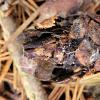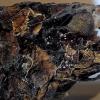
21-12-2025 09:32
Hello.A tiny ascomycete found embedded in wood in

21-12-2025 21:32
Pol DebaenstHello, Garden, Burgweg 19, Veurne, BelgiumOn 10/1

22-12-2025 23:38
Patrice TANCHAUDBonsoir, récolte sur un mur en pierre, apothéci

22-12-2025 00:47
Patrice TANCHAUDBonsoir, récolte à proximité du milieu dunaire

21-12-2025 21:40
Isabelle CharissouBonjour, j'aimerais connaitre les références de

20-12-2025 23:08
Patrice TANCHAUDBonsoir, récolte sur sol sablonneux dans l'arri�
• Hairs and spores suggest Hyaloschypha (s.s.).
• Simple septa, rings, hairs, spores and substrate seem to suggest H. herbarum.
Habitat: On a decaying cone of Pinus sylvestris, mostly on the more sheltered inner parts, damp when found, on the floor with litter, under several large trees, on a sparsely wooded hillside, 197 m alt., Old Lodge nature reserve, Ashdown Forest, High Weald, southern England, early-November.
Apothecia: Tiny whitish discs, gregarious to 2-caespitose, sessile.
Macro: Diameter < ~0.5 mm, whitish-translucent, occasionally yellowish, initially more cupulate, then discoid-pulvinate and +/- appressed, margin more whitish, becoming flattened and often slightly uneven, with dense and short whitish hairs pointing outwards and some longer ones, disc distinctly convex in maturity, more translucent with the dark substrate showing in the centre, grainy appearance (hymenial cells).
Asci: Turgid ~(45) 50-60 x 7-8 um, simple septa, rings bb.
Spores: Cylindrical-allantoid to slightly clavate, usually approx. homopolar, ends rounded, tapering slightly, usually ~3-5 small LBs grouped at each pole, OCI 2-3, asymmetric or sometimes slightly to distinctly curved.
Free living spores in water:
(9.4) 10.3-13.1 (14.7) × (2.2) 2.6-3.0 (3.2) µm, Q = (3.5) 3.7 - 4.9 (5.3), N = 35, mean = 11.9 × 2.8 µm, Q mean = 4.2.
Paraphyses: Cylindrical, apex not noticeably inflated, width ~2-2.5 um.
Medullary: Some horizontal hyphae seen, otherwise ?
Ectal: Text. prismatica, at the base more round, slightly larger cells at the flanks and often branching before becoming hair-like, general dextrinoid reaction.
Marginal hairs: A few long and cylindrical, length ~70-100 x 2-3 um, apex rounded, otherwise short and tapering, ~25-40 x 5 um, at the apex ~1 um wide, conical to distinctly lageniform, with an apical inflation, blunt/obtuse, appearing smooth, possibly a slight amyloid reaction at apices.

Thank you, I guess it's H. herbarum s.l. for now then. It's a shame there isnt enough genetic data to explore your hypothesis. As pointed out by Huhtinen in his monograph, there could also be some confusion with the quite similar H. (fuckelii var.) alniseda.
I thought the morphology seemed to fit with Huhtinen's concept, although there is no mention of the longer cylindrical hairs. The spore length and curvature seem quite variable, but the range of lengths given by Huhtinen is very broad and includes the longest spores in the genus.
I noticed the observation 1.X.2019 in your folder reports spores that are distinctly wider than Huhtinen's range, the asci are also larger, and many of the hairs look longer (possibly also noticeable in macro).
Huhtinen does also comment on the uncharacteristic and wide substrate range of H. herbarum, but suggests the cultures are morphologically similar and also grow faster. The precise substrate range doesn't seem clear but he only reports a single collection on Pinus, on bark, and otherwise they are all on angiosperms. Most records in the UK (with substrate data) report herbaceous material, but one says 'log, fallen, Pinus'.




 Hymenium-0031.jpeg
Hymenium-0031.jpeg